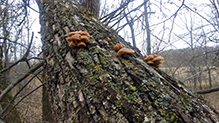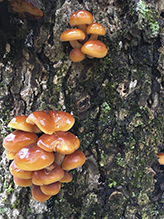Velvet Foot
(Flammulina velutipes)
Conservation • Description • Habitat • Ecology • Use • Distribution • Taxonomy
Conservation Status |
|
|||||||
| IUCN Red List | not listed |
|||||||
| NatureServe | not listed |
|||||||
| Minnesota | not listed |
|||||||
Description |
||
Velvet Foot is a late season, cold weather, gill mushroom. It is extremely widespread, occurring throughout Europe, across North America, and in Japan. It is fairly common in Minnesota. It appears in the late fall in deciduous and mixed forests and woodlands. It grows in dense clusters on stumps, logs, and living trunks of hardwoods, especially elm. It obtains its nutrients from both dead wood (saprobic) and living wood (parasitic). The cap is ⅜″ to 2 ¾″ in diameter and convex at first with the margins curved down and in. As it matures it becomes broadly convex or flat, sometimes with a raised “bump” in the center. The upper surface is smooth and hairless, and has no scales. It is slimy when wet, viscid when moist or fresh, dry only in arid conditions. The cap color is somewhat variable. It may be reddish-brown, yellowish-brown, orangish-brown, or yellowish-orange. It fades with age and in dry weather. The stalk is tough, smooth, slender, ¾″ to 4″ long, and⅛″ to ½″ thick. It bends at the base then grows straight up. It is pale and colorless or yellowish to orangish-brown at first. As it ages it develops a dense covering of dark velvety hairs beginning at the base and progressing upwards. There is no ring around the stalk. The flesh is thin and white or yellowish. It is edible but due to its similarity in appearance to the poisonous Funeral Bell (Galerina marginata) it should be avoided. Making matters worse, Funeral Bell often grows in close proximity to Velvet Foot. The gills are closely spaced and white to pale yellow. They are broadly to narrowly attached to the stalk, sometimes notched at the point of attachment. The spore print is white. |
||
Similar Species |
||
| Funeral Bell (Galerina marginata) has a ring around the stalk, the remnants of the partial veil, but this often disappears with age. | ||
Habitat and Hosts |
||
Deciduous and mixed forests and woodlands |
||
Ecology |
||
Season |
||
Late fall |
||
Use |
||
A Japanese cultivar of Velvet Foot, known as Enokitake or Enoki, is white and grows in dense clusters. It has very small caps and very long slender stalks. To achieve this, it is grown in complete darkness in a carbon dioxide rich environment. Producing more than 300,000 tons per year at the end of the twentieth century, it is one of the six most actively cultivated mushrooms in the world. In 1993, Velvet Foot mushrooms were grown on the space shuttle to test the effects of zero gravity. As expected, the mushrooms grew in all directions. |
||
Distribution |
||||
|
Sources |
|||
| 9/25/2022 | ||||
Occurrence |
||||
Very widespread and fairly common |
||||
Taxonomy |
|||
| Kingdom | Fungi (Fungi) | ||
| Subkingdom | Dikarya | ||
| Phylum | Basidiomycota (Basidiomycete Fungi) | ||
| Subphylum | Agaricomycotina (Higher Basidiomycetes) | ||
| Class | Agaricomycetes (Mushrooms, Bracket Fungi, Puffballs, and Allies) | ||
| Subclass | Agaricomycetidae | ||
| Order | Agaricales (Common Gilled Mushrooms and Allies) | ||
| Suborder | Marasmiineae | ||
| Family | Physalacriaceae | ||
| Genus | Flammulina | ||
Velvet Foot species was formerly classified as Collybia velutipes. In 1951 it was given its own genus Flammulina based on the viscid cap and sterile cells in the gills. At that time it was once thought that the new genus consisted of just this species, F. velutipes. Following detailed studies of collected specimens worldwide there are now twelve species recognized in the genus. |
|||
Synonyms |
|||
Agaricus velutipes Collybia velutipes |
|||
Common Names |
|||
Enoki Enokitake Velvet Foot Velvet Shank Velvet Stem Winter Mushroom |
|||
Glossary
Saprobic
A term often used for saprotrophic fungi. Referring to fungi that obtain their nutrients from decayed organic matter.
Visitor Photos |
|||||
Share your photo of this fungus. |
|||||
| This button not working for you? Simply email us at info@MinnesotaSeasons.com. Attach one or more photos and, if you like, a caption. |
|||||
Ben A |
|||||
 |
 |
||||
 |
|||||
Ginger Halverson |
|||||
 |
 |
||||
Matt Sundquist |
|||||
 |
 |
||||
 |
|||||
MinnesotaSeasons.com Photos |
|||||
|
|||||

Slideshows |
||
| Winter Mushroom Andree Reno Sanborn |
||

|
||
About
Flammulina velutipes |
||
| Flammulina velutipes miguel angel |
||

|
||

Visitor Videos |
|||
Share your video of this mammal. |
|||
| This button not working for you? Simply email us at info@MinnesotaSeasons.com. Attach a video, a YouTube link, or a cloud storage link. |
|||
Other Videos |
|||
| Meet the vibrant velvet shank (Flammulina velutipes) Lisa Cutcliffe |
|||
About
Published on Jan 1, 2015 Edulis wild food guide Lisa C introduces you to a voluminous group of velvet shanks (Flammulina velutipes), taking you through the key ID points for this common and distinctive winter mushroom. This particular cluster has dry caps (they are usually very slimy) so all the nicer for eating! Happy new year and happy foraging :) Found on 1 January 2015 in Bradford, Yorkshire, UK Important safety information: * Remember that you alone are responsible for what goes into your mouth. Never eat anything based upon an ID from a single online source (such as this video) alone, always research your own finds further using multiple reliable sources and become absolutely sure of the ID for yourself. * Most wild fungi and some wild plants and fruits must be cooked before they are safe to eat. Always research how wild food species should be prepared before consuming it. |
|||
| On Velvet Foot Mushrooms The Richest Fare |
|||
About
Published on Apr 18, 2016 A brief overview of the velvet foot mushroom as a wild edible. WARNING: This mushroom has a deadly look alike! It is not a beginner's mushroom. Consult a local expert! Go to therichestfare.com for more about real food, healthy living and spiritual encouragement. |
|||


Created: 10/10/2018
Last Updated:


